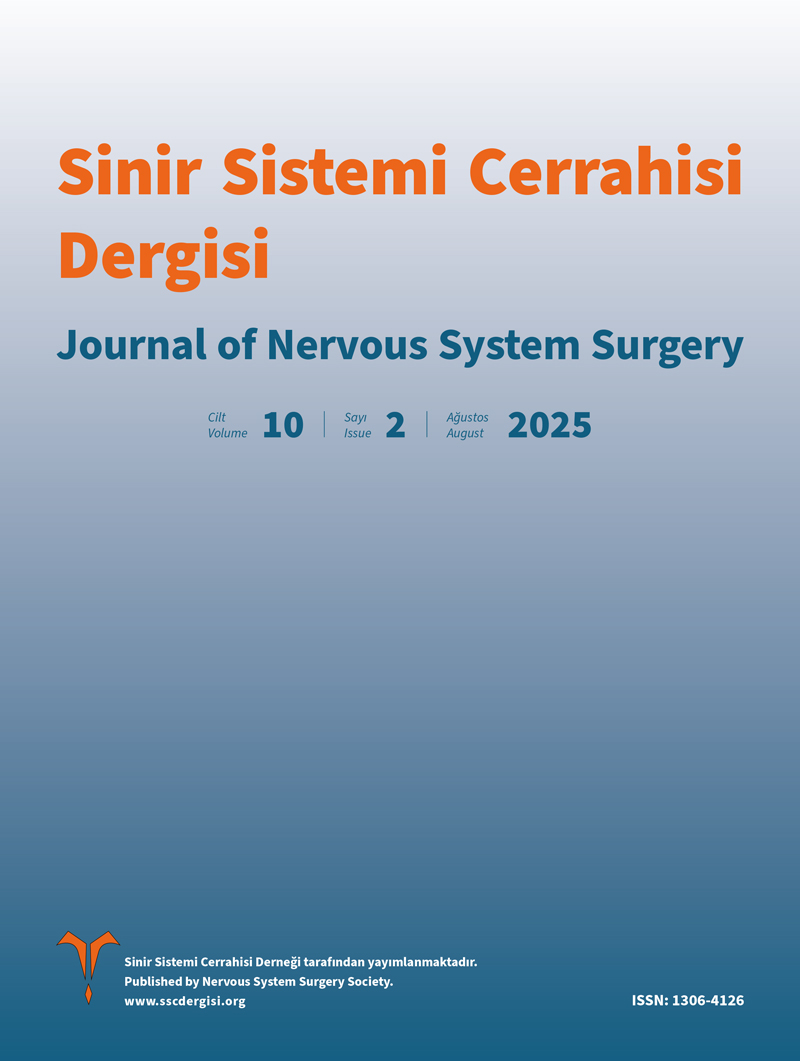Abstract
Introduction: Pediatric intracranial aneurysms are considerably rarer than those in adults and differ significantly in terms of clinical, radiological, and anatomical characteristics. Congenital and acquired factors are known to play an important role in the etiology of aneurysms in childhood. This study aims to evaluate the demographic features, clinical findings, treatment methods, and outcomes of pediatric intracranial aneurysm cases treated in our institution.
Materials and Methods: Pediatric patients aged 0–18 years who were diagnosed and treated for intracranial aneurysms at our clinic between January 2010 and December 2024 were retrospectively reviewed.
Results: A total of 9 pediatric patients were treated for intracranial aneurysms during the study period. The mean age was 10.6 years; six patients were male and three were female. The most common presenting symptoms were headache (55%) and nausea/vomiting (55%). At admission, three patients were classified as WFNS Grade V and four as WFNS Grade I. Subarachnoid hemorrhage (SAH) was observed in seven patients (77.8%). Eight aneurysms were located in the anterior circulation and one in the posterior circulation. The most frequently affected vascular segments were the internal carotid artery and the middle cerebral artery bifurcations. Endovascular coiling was performed in eight patients (88.9%), while surgical clipping was applied in one patient (11.1%). Six patients were discharged with full recovery, one patient was discharged with a neurological deficit due to an intraparenchymal hematoma, and two patients died during intensive care follow-up. During the postoperative period, one patient underwent decompressive craniectomy and another required external ventricular drainage (EVD) due to hydrocephalus.
Conclusion: Pediatric intracranial aneurysms exhibit distinct clinical and radiological features compared to adults. The incidence of subarachnoid hemorrhage is relatively high and predominantly involves the anterior circulation. Although endovascular coiling appears to be more frequently preferred over surgical clipping, treatment strategies should be tailored based on patient-specific factors.
Keywords: pediatric intracranial aneurysms, subarachnoid hemorrhage, endovascular treatment
References
- Huang J, McGirt MJ, Gailloud P, Tamargo RJ. Intracranial aneurysms in the pediatric population: case series and literature review. Surg Neurol 2005; 63: 424-432. https://doi.org/10.1016/j.surneu.2004.11.023
- Proust F, Toussaint P, Garniéri J, et al. Pediatric cerebral aneurysms. J Neurosurg 2001; 94: 733-739. https://doi.org/10.3171/jns.2001.94.5.0733
- Brandel MG, Plonsker JH, Rennert RC, et al. Treatment of pediatric intracranial aneurysms: institutional case series and systematic literature review. Childs Nerv Syst 2024; 40: 2419-2429. https://doi.org/10.1007/s00381-024-06384-x
- Aryan HE, Giannotta SL, Fukushima T, Park MS, Ozgur BM, Levy ML. Aneurysms in children: review of 15 years experience. J Clin Neurosci 2006; 13: 188-192. https://doi.org/10.1016/j.jocn.2005.07.006
- Allison JW, Davis PC, Sato Y, et al. Intracranial aneurysms in infants and children. Pediatr Radiol 1998; 28: 223-229. https://doi.org/10.1007/s002470050336
- Juvela S. Risk factors for multiple intracranial aneurysms. Stroke 2000; 31: 392-397. https://doi.org/10.1161/01.str.31.2.392
- Buis DR, van Ouwerkerk WJR, Takahata H, Vandertop WP. Intracranial aneurysms in children under 1 year of age: a systematic review of the literature. Childs Nerv Syst 2006; 22: 1395-1409. https://doi.org/10.1007/s00381-006-0142-3
- Santos-Franco JA, Cruz-Argüelles CA, Agustin-Aguilar F, Abrego-Salinas AA, Casas-Martínez MR, Olivares-Peña JL. Intracranial aneurysms in pediatric population treated with flow diverters: a single-center experience. Surg Neurol Int 2022; 13: 522. https://doi.org/10.25259/SNI_873_2022
- Deora H, Rao KVLN, Somanna S, Srinivas D, Shukla DP, Bhat DI. Surgically managed pediatric intracranial aneurysms: how different are they from adult intracranial aneurysms? Pediatr Neurosurg 2017; 52: 313-317. https://doi.org/10.1159/000477815
- Sekhar LN, Heros RC. Origin, growth, and rupture of saccular aneurysms: a review. Neurosurgery 1981; 8: 248-260. https://doi.org/10.1227/00006123-198102000-00020
- Stehbens WE. Etiology of intracranial berry aneurysms. J Neurosurg 1989; 70: 823-831. https://doi.org/10.3171/jns.1989.70.6.0823
- Lasjaunias P, Wuppalapati S, Alvarez H, Rodesch G, Ozanne A. Intracranial aneurysms in children aged under 15 years: review of 59 consecutive children with 75 aneurysms. Childs Nerv Syst 2005; 21: 437-450. https://doi.org/10.1007/s00381-004-1125-x
- Jian BJ, Hetts SW, Lawton MT, Gupta N. Pediatric intracranial aneurysms. Neurosurg Clin N Am 2010; 21: 491-501. https://doi.org/10.1016/j.nec.2010.03.005
- Agid R, Souza MPS, Reintamm G, Armstrong D, Dirks P, TerBrugge KG. The role of endovascular treatment for pediatric aneurysms. Childs Nerv Syst 2005; 21: 1030-1036. https://doi.org/10.1007/s00381-005-1152-2
- de Aguiar GB, Ozanne A, Elawady A, et al. Intracranial aneurysm in pediatric population: a single-center experience. Pediatr Neurosurg 2022; 57: 270-278. https://doi.org/10.1159/000524523
- Meyer FB, Sundt TM, Fode NC, Morgan MK, Forbes GS, Mellinger JF. Cerebral aneurysms in childhood and adolescence. J Neurosurg 1989; 70: 420-425. https://doi.org/10.3171/jns.1989.70.3.0420
- Zhou S, Dion PA, Rouleau GA. Genetics of intracranial aneurysms. Stroke 2018; 49: 780-787. https://doi.org/10.1161/STROKEAHA.117.018152
- Ghali MGZ, Srinivasan VM, Cherian J, et al. Multimodal treatment of intracranial aneurysms in children: clinical case series and review of the literature. World Neurosurg 2018; 111: e294-e307. https://doi.org/10.1016/j.wneu.2017.12.057
- Garg K, Singh PK, Sharma BS, et al. Pediatric intracranial aneurysms-our experience and review of literature. Childs Nerv Syst 2014; 30: 873-883. https://doi.org/10.1007/s00381-013-2336-9
- Sanai N, Quinones-Hinojosa A, Gupta NM, et al. Pediatric intracranial aneurysms: durability of treatment following microsurgical and endovascular management. J Neurosurg 2006; 104: 82-89. https://doi.org/10.3171/ped.2006.104.2.3
- Kakarla UK, Beres EJ, Ponce FA, et al. Microsurgical treatment of pediatric intracranial aneurysms: long-term angiographic and clinical outcomes. Neurosurgery 2010; 67: 237-49. https://doi.org/10.1227/01.NEU.0000371727.71991.64
- Sharma BS, Sinha S, Mehta VS, Suri A, Gupta A, Mahapatra AK. Pediatric intracranial aneurysms-clinical characteristics and outcome of surgical treatment. Childs Nerv Syst 2007; 23: 327-333. https://doi.org/10.1007/s00381-006-0253-x
- Saraf R, Shrivastava M, Siddhartha W, Limaye U. Intracranial pediatric aneurysms: endovascular treatment and its outcome. J Neurosurg Pediatr 2012; 10: 230-240. https://doi.org/10.3171/2012.5.PEDS1210
Copyright and license
Copyright © 2025 The Author(s). This is an open access article distributed under the Creative Commons Attribution License (CC BY), which permits unrestricted use, distribution, and reproduction in any medium or format, provided the original work is properly cited.






